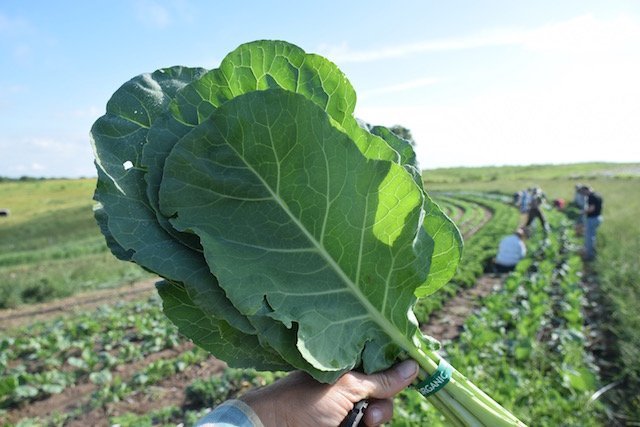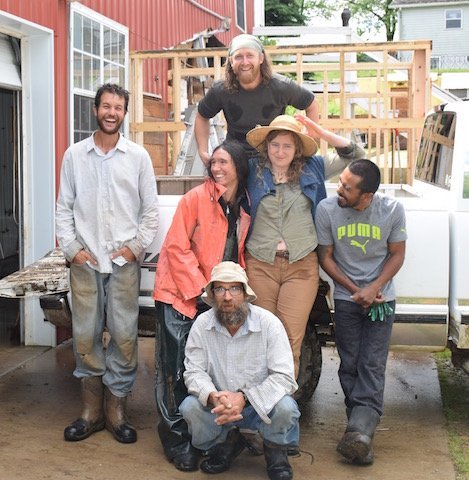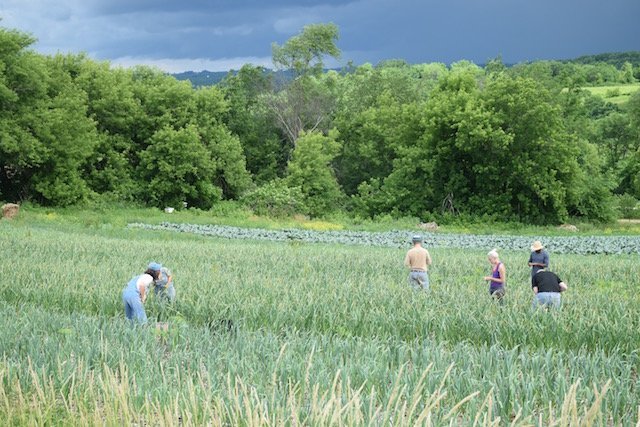
Strawberries are here! Strawberries are something we were reluctant to take on in the early years of our farm. We just didn’t know the process – the spacing at which to plant them, what varieties, how far apart are the rows? How many plants to put in?
But four years ago we decided that we were no longer afraid! We had a cultivating tractor (to help keep the rows weeded). We had done our research and we knew that having our own home-grown strawberries for our CSA members would be a huge hit! The very next year we had more berries than what we could pick. We quickly learned that we would need to bring in extra workers during Strawberry season to help get the highly perishable berries picked fast. 
You will notice that our local strawberries may look and taste much different from strawberries you buy from the store brought in from California. The golden state grows them as annuals and re-plants them every year on plastic with a drip-line and fertilizer feed. On our farm we plant them the first year and don’t harvest until the second year. We pick the same patch for three years and then turn it under. The berries are larger the first year and seem to go down in size and production the following two years, but still produce somewhat heavily.
We are picking from two different patches this season. One variety is Honey-O and the other variety is Darselect. At the end of each season we blanket the strawberry field with a fodder mulch (some farms use oat straw) to protect the roots from the harsh Wisconsin winters. In the Spring the mulch is raked back to expose the mother plant and at that time the plants emerge and begin to sprawl out.
Strawberries are said to have gotten their name because the plant vines out and sends runners in every direction multiplying with new plants growing in every direction. The plants runners are “strewn” about straying and strewing in all directions. A less popular theory is that all of the tiny seeds on the surface of the berry resemble straw or chaff or mote – describing the appearance of the achenes (little seeds) all over the berries. In England, where the word “strawberry” was said to have originated, they grew in the wild long before they were cultivated or farmed in such a way that straw was applied to the patches. 
On our farm we harvest strawberries when they are all the way ripe. We do not pick under-ripe berries which makes them a highly perishable product. Once they are harvested, we put them in our walk-in cooler immediately and there they sit until delivery day. Once they have been removed from the cooler on delivery day, they should be consumed immediately. We do not recommend trying to hold onto your berries for much longer than a day. Eat em up! But maybe you don’t need to be told that and they will have all been eaten on your drive home before you’ve even had a chance to read this newsletter! We recommend making a fresh strawberry cream pie because there are few things in life that are better than fresh strawberries served on top of a lightly sweetened cream cheese folded in with whipped cream on top of a graham cracker crust. Take it from me!
Strawberries!- These beauties are at the top of your box so they dont get smooshed and so that they don’t get water dripped on them from wet lettuce or other wet veggies.
Rouxai Red Oakleaf Lettuce or Green Butterhead leattuce- The lettuces this week are so tender and succulent. How lucky we are to have all of this buttercruch lettuce so smooth and soft to make gorgeous spring salads with! We had a very muddy and rainy harvest morning, but we did our absolute best and put a lot of extra effort and time into getting all of the mud off of the lettuce this week. Will keep best in a plastic bag in the fridge.
Red Buttercrunch lettuce- Another fabulous lettuce offering. This is gourmet stuff here folks! These lettuces are so tender, I just want to eat salad for every meal. Think taco salads this week with the cilantro and lettuce combo in the box. Make chicken salads. Seven layer salads. Avocado salads. Keeps best in a plastic bag in the fridge. 
Garlic Scapes- These are the long and skinney things that look a bit like a long string bean or somthing, but they should smell stronly of garlic. These scapes are the garlic plant’s effort at making a seed head. Each garlic plant makes one scape. If snapped off, the garlic plant will put more of it’s energy into making a nice big garlic bulb rather than putting it’s energy into making a seed head bulbus. Fortunatley for us, these scapes are delicious to eat! Start chopping them up with your knife at the base of the bunch and use the little green chopped pieces like garlic in your soups, stir fries, pastas, eggs or wherever you might ordinarily cook with garlic! You can also make a garlic scape pesto which has become very popular. We like the chop up the garlic scapes beginning from the base of the bunch up until the little nodules on the scape- the rest of the scape is still edible but a little more chewy.
White and Purple Kohlrabi- Each member received one white kohlrabi and one purple kohlrabi. Cut the leaves off of the top of the kohlrabi and use them in your cooking like kale. Using a pearing knife or a small knife, peel the outer edge of the kohlrabi off before you eat it. These kohlrabis are so mild and tender and have a hint of sweetness to them! Once a kohlrabi has been cut open, the flavor is best if it is eaten within an few hours. Also wonderful if chopped into veggie sticks, sprinkled with salt and eaten raw and whole! Kohlrabi is also called the “ground apple” because its texture is so much like that of an apple.
Collard Greens- I knew that you probably could not contain your excitement when you found collard greens, but these truly are a special treat! If cooked well, collards can be a nutritious and delicious side! They can be used in cooking a lot like any other cooking green, but they do take a bit longer to cook. Check out a traditional recipe below.
Cilantro- The cilantro was showing signs of bolting from all of the heat we had. We had a lot of it too, so generous bunch sizes this week! Cilantro typically does not like to get wet. We did have to wash it since it was such a muddy harvest week. We recommend using it up as quickly as possible. Unless you want it to last longer, you could take the rubber band off the bottom of the bunch, wash it again if you think it looks dirty around the base of the rubber band, and then salad spin it good and dry and store it in a plastic bag in the fridge.
Radishes!- We never thought we would get another harvest week out of these, but they still looked and tasted amazing. This will be the final radish giving until fall when the cooler growing temps return. Great if you cut the tops off of them and let them float in a bowl of water in your fridge and just snack on them throughout the day. Some people even add them to a stir fry. Their texture is wonderful when cooked! Radish greens are so green, mild and nutritious, don’t let those go to waste!
Hakurai Salad Turnips- These are such a soft and smooth salad turnip! Great for slicing up thinly and adding to your salads. Turnip greens could also be added to a quiche and no one would ever notice that they weren’t spinach!
Next Week’s Best Guess: Lettuce x2, kohlrabi x 2, dill, swiss chard, broccoli, zucchini, summer squash, strawberries, garlic scapes, peas, maybe green onions
Collards Recipe with Bacon and Potatoes
Glazed Hakurai Turnips Recipe with greens